What’s happening to the middle class in Eastern Europe?
by Ben Slay, senior economist with UNDP’s Regional Bureau for Europe and Central Asia
If you talk to someone whose country emerged from behind the iron curtain 30 years ago, you are likely to hear complaints about how things are a lot less equal today than they used to be.
Communism may have deprived people of their rights and limited their opportunities. But the absence of huge gaps between rich and poor seems to have been widely appreciated. Moreover, many people — workers, intellectuals, school teachers, middle managers — saw themselves as part of the socialist middle class. Not rich, but not poor, either.
When the Berlin wall fell, much of the Soviet Union and Yugoslavia collapsed into hyperinflation and armed conflict. Millions of people in the new countries that emerged from the transition were impoverished. At the same time, a new class of wealthy capitalists and entrepreneurs also emerged. Large gaps between the rich and the poor returned.
But are the statistics consistent with this narrative?
Official data from most of these countries during the first decade of the post-communist transition generally bear this story out. For instance, the Gini coefficient — a standard inequality measure — for Kyrgyzstan more than doubled, rising from 26 in 1987 to 54 in 1993. Likewise, the Gini for Moldova rose from 24 in 1987 to 39 in 1999.
But then, the data point to stabilization. Economic growth returned, and the middle class made a comeback — roughly tripling in size during 2000–2013. And reported income inequalities in many of the countries fell to Scandinavian levels. By 2017, the Gini coefficients for income inequality in Moldova and Kyrgyzstan had fallen back to 26 and 27, respectively. Denmark, Finland, Norway, and Sweden report Ginis in this range.
This is what the official figures show, at least. But many people don’t believe them. Popular perceptions of huge gaps between the rich and poor and an impoverished former middle class seem to persist.
To shed light on these issues, UNDP analyzed the World Bank’s household budget survey data for 16 middle-income economies in Europe and Central Asia. Using the $10/day income level in purchasing-power-parity terms to define the middle class, we found that some 7 million people dropped below this threshold during 2014–2015.
This squeeze on the middle class was particularly pronounced in Armenia, Belarus, Kazakhstan, Tajikistan and Ukraine. Recession in Russia, the main trading partner for most of these countries, and the economic crisis that took hold in Ukraine after 2013, seem to account for most of this.
Fortunately, these data indicate that some 2 million people managed to climb back above the $10/day threshold during 2016–2017. Still, the middle class in the region was smaller in both absolute and relative terms in 2017 than it was in 2013.
What does this all mean?
The economic growth and broad improvements in living standards the region has enjoyed since the dark days of the 1990s are difficult to deny. Things clearly have gotten better for many people in the new millennium.
But it may also be the case that these improvements have now ground to a halt. This might help explain the unexpected popular uprising that swept Armenia’s old guard from power in 2018, as well as the continuing socio-political ferment in Ukraine.
Which countries might be the next to face the implications of the shrinking middle class? Unfortunately, a possible global economic slowdown, the uncertain future of work heralded by the spread of digitalization and artificial intelligence, and rapidly aging populations cast dark clouds on efforts to keep inequality at bay.
As UNDP’s 2019 Human Development Report shows, high levels of vulnerable employment, fraying social safety nets and outmigration of skilled and young workers are putting progress at risk in many of these countries. And with the ratio of highly skilled to low-skilled workers only half that of OECD countries, the region will face an uphill battle to catch up with an increasingly automated global economy.
Together with a severe climate crisis that could entrench new forms of vulnerability among at-risk groups, the region could be in for a turbulent ride.
But the good news is none of this is inevitable. Countries of the region could enact comprehensive measures to update skills for both women and men, reduce labor taxes to boost the job market and strengthen social safety nets for the most vulnerable. That, and doubling efforts to accelerate the energy transition, could move economies forward on a new path to sustainable development.
It wouldn’t be the first time this region goes through a massive reinvention.
Editors note: Around the Europe and Central Asia region, people and societies are making a new start in the aftermath of turmoil and working to overcome the barriers that still persist in the region. Someone once wrote, “Although no one can go back and make a brand new start, anyone can start from now and make a brand new ending.”
Experience the new issue of Voyages now, which looks at reinvention across Eurasia.
